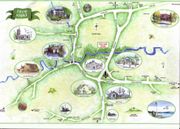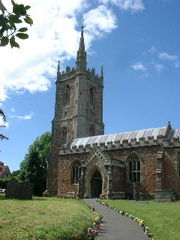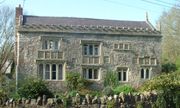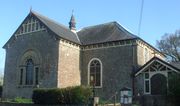Chew Stoke
2007 Schools Wikipedia Selection. Related subjects: Geography of Great Britain
| Chew Stoke | ||
|---|---|---|
|
|
||
| Statistics | ||
| Population: | approx. 1000 | |
| Ordnance Survey | ||
| OS grid reference: | ST555615 | |
| Administration | ||
| District: | Bath and North East Somersets | |
| Region: | South West England | |
| Constituent country: | England | |
| Sovereign state: | United Kingdom | |
| Other | ||
| Ceremonial county: | Somerset | |
| Historic county: | Somerset | |
| Services | ||
| Police force: | Avon and Somerset | |
| Fire and rescue: | Avon | |
| Ambulance: | South Western | |
| Post office and telephone | ||
| Post town: | BRISTOL | |
| Postal district: | BS40 | |
| Dialling code: | 01275 | |
| Politics | ||
| UK Parliament: | Wansdyke to be North East Somerset from next general election. | |
| European Parliament: | South West England | |
Chew Stoke is a small village within the Chew Valley, in the county of Somerset about eight miles south of Bristol, England. The village is at the northern edge of the Mendip Hills Area of Outstanding Natural Beauty and within the Bristol/ Bath Green Belt. The parish includes the hamlet of Breach Hill, which is approximately two miles southwest of the village.
The village has a long history, illustrated by the range of listed buildings, and now lies at the northern end of Chew Valley Lake close to the dam, pumping station, sailing club and fishing lodge. A tributary of the River Chew runs through the village, possibly called Strode Brook, as it rises in the village of Strode, although it is not named on any maps.
The village has a population of about 1,000 and has one shop, two pubs, a primary school and a bowling club. With Chew Magna it forms the Chew Valley North Ward in the Bath and North East Somerset Unitary Authority Council Area. Chew Valley School for secondary pupils and its associated leisure centre is less than a mile away from Chew Stoke. The village has some light industrial units, but is largely agricultural, with many residents commuting to nearby cities for employment.
Geography and transportation
Chew Stoke is located in the Chew Valley approximately 10 miles (16 km) south of Bristol, 15 miles (25 km) from Bath and 9 miles (15 km) from Keynsham. It is 1.3 miles (2 km) south of Chew Magna which is on the B3130 which joins the A37 and A38. Most of the roads in the area are small lanes, although the valley is crossed by the A368. The "Chew Valley Explorer" bus route 672/674 provides occasional public transport access.
In 2002 a 1.9-mile (3 km) safe cycle route, the Chew Lake West Green Route, was opened around the western part of the lake from Chew Stoke. It forms part of the Padstow to Bristol West Country Way, National Cycle Network Route 3. It has all-weather surfacing, providing a smooth off-road facility for ramblers, mobility-challenged visitors and cyclists of all abilities. It was funded by Bath and North East Somerset Council with the support of Sustrans and the Chew Valley Recreational Trail Association. Minor roads around the lake are also frequently used by cyclists.
Bristol International Airport is approximately 10 miles (15 km) away. The nearest train stations are at Keynsham, Bath and Bristol.
History
Prehistory
Evidence of early occupation of the area was uncovered during archaeological excavations carried out by Philip Rahtz and Ernest Greenfield employed by the Ministry of Works, from 1953 to 1955. The excavations found evidence of people belonging to the consecutive periods known as Upper Palaeolithic, Mesolithic and Neolithic (Old, Middle and New Stone Age), Bronze Age and Iron Age, including implements such as stone knives, flint blades and the head of a mace, along with buildings and graves.
Romano-Celtic temple
Chew Stoke boasts a Romano-Celtic temple, excavated by Philip Rahtz between 1949 and 1951, which was originally thought, on its discovery in 1830, to be a beacon, for signalling between adjoining hillforts. This double-octagonal temple building was comprised of an inner wall, which formed the cella, surrounded by an outer wall forming an ambulatory, or covered walkway, is situated on a promontory overlooking the River Chew. The outer portico measures about 56½ feet in diameter, the inner cellar about 32 feet across; all walls are about 3 feet thick. Along each wall were two features described by Rahtz as buttresses but were more likely to have been pilasters, as their small size would render them ineffective as wall supports. Rodwell suggests that the ambulatory would have been cross-vaulted and the pilasters used as external supports for this. This would allow for a good deal of natural light to circulate the building and give an aesthetically balanced look to the structure. The ambulatory would then give the illusion of a labyrinth of side chambers running off from the central area. The temple faced east and was first built in the late-3rd century. After the collapse of the original building another temple was built, again to fall into ruin. The final rebuild, after about AD 367 included the addition of an internal screen. The building finally collapsed in the 5th century. The site of the temple is on the aptly named Pagans Hill, although any link to the site in the naming of the road has been lost in the mists of time.
It is likely that there was other occupation during Roman times in the village, as there is in the surrounding area, although no definitive evidence has been found.
Middle Ages
During the Middle Ages farming was the most important activity in the area. There is also evidence of lime kilns, which were used in the production of mortar for the construction of local churches. Farming, both arable and dairy, continues today. There were also a variety of orchards for fruit production, including apples, pears and plums.
In the Domesday Book of 1086 it is listed at Chiwestoche, and belonged to Gilbert Fitz-Turold. He conspired with the Duke of Normandy against king William Rufus and subsequently all his lands were seized. The next recorded owner was Lord Beauchamps of Hatch, by whom it was held underthe Honour of Gloucester.
Bilbie family of bell and clockmakers
Chew Stoke had a remarkable family of " bell founders and clockmakers" who lived and worked there for more than 200 years, from the late 1600s until the 1800s. The Bilbie family produced more than 1,350 bells, which are hung in churches all over the West Country. The oldest bell, cast in 1698, is still giving good service in St Andrew's Church. Their clocks date from 1724 and are highly prized. They produced mostly longcase clocks, the cheapest with 30-hour movements in modest oak cases, but they also made high quality 8-day movements with additional features such as including the high tide at Bristol docks. These were fitted into quality cabinet-maker cases that now command the highest prices.
Recent history
In the 20th century the village has expanded slightly with the building of new houses, particularly to house residents of the area of the Chew Valley Lake who had to be moved in the 1950s when the lake area was flooded.
In World War II 42 children and 3 teachers who had been evacuated from Avenmore school in London were accommodated in the village.
On 10th July 1968 torrential rainfall led to widespread flooding in the village, which water reaching the first floor of many buildings. The damage in the village was not as severe as in some of the surrounding villages such as Pensford, however fears that the dam of Chew Valley Lake would be breached caused considerable anxiety in the village.
Her Royal Highness Anne, Princess Royal buried a time capsule at the new Rural Housing Trust development at Salway Close, which had been built in the previous year and newly opened, on Friday, 2 February 2001. The capsule contained items describing the life and history of the village, including a video of millennium celebrations, from scheme residents, Chew Stoke Women's Institute and the parish council.
Each year, over a weekend in September at "Harvest Home" is held in the village with horse and pet shows, bands, a fun fair and a variety of entertainment.
The Radford's factory site within the village, which used to be involved in the manufacture of refrigeration equipment, has been identified as a brownfield site suitable for residential use in the 2002 Draft Local Plan of Bath and North East Somerset. It has been a matter of some controversy surrounding planning permission and the balance between residential, social and employment uses.
Government and politics
Chew Stoke has its own Parish council which has some responsibility for local issues. The village is part of the Chew Valley North Ward on the Bath and North East Somerset Unitary Authority which has wider responsibilities for services such as education, refuse, tourism etc, it is currently represented by Councillor Malcolm Hannay, a Conservative. The village is a part of the Wansdyke constituency which elects one MP to the Westminster Parliament and part of the South West England constituency which elects 7 members to the European Parliament. The sitting Member of Parliament for Wansdyke is Dan Norris, a member of the Labour Party.
Demographics
According to the 2001 Census the Chew Valley North Ward (which includes Chew Magna and Chew Stoke), had 2,307 residents, living in 911 households, with an average age of 42.3 years. Of these 77% of residents describing their health as 'good', 21% of 16–74 year olds had no qualifications; and the area had an unemployment rate of 1.3% of all economically active people aged 16–74. In the Index of Multiple Deprivation 2004, it was ranked at 26,243 out of 32,482 wards in England, where 1 was the most deprived LSOA and 32,482 the least deprived.
Points of interest
Bridges
In the old centre of the village, which is now quiet as the main road takes a different route through the village, is an old stone packhorse bridge which is now pedestrian only. Just below it is an Irish bridge which is dry in summer and a ford in winter, which was built in the 1950s.
St Andrews Church
St Andrews Church, which was constructed in the 15th Century and underwent extensive renovation in 1862, is on the outskirts of the village. In the churchyard is the reconstructed Moreton Cross which was moved here when Chew Valley Lake was flooded. Within the church itself there is a memorial plaque to the Bilbie family of bell founders and clock makers, and just inside the porch on the left of the church door, is a stone figure holding an anchor which was moved to the church from Walley Court with the flooding of the lake. There is an unconfirmed story that this was given to the Gilbert family, then living at the court by Queen Elizabeth I. The inside of the church is decorated with 156 angels in wood and stone. The church is Grade II* listed. The church includes a tower with an unusual spirelet on the staircase turret, and contains bells cast by the Bilbie family in the village. The base of cross shaft in the churchyard about 24 metres south west of the tower is thought to date from the 14th Century and is a Grade II* listed building, as is the Webb monument in the churchyard. The churchyard gate, at the south east entrance, bears a lamp which was provided by public subscription to commemorate Queen Victoria's Jubilee of 1897. Itself a Grade II listed structure. Within the church are bronze plaques commemorating the eleven people from the village who died in World War I and six from World War II. There is also a stained glass window showing a saint with a sword standing on a snake and crossed flags commemorating those from World War II.
Rectory
The village hall is at the end of Church Lane, opposite the Rectory which is believed to have been built in 1529 by the rector, Sir John Barry, (Rector 1524–46). It has undergone substantial renovations including the addition of a clock tower for the Rev. W.P. Wait, which has since been removed and further alterations c.1876 for Rev. J. Ellershaw. The building has an ornate south front with carvings of shields bearing the coat of arms of the St Loe family, who were once chief landowners in the area, alone or impaled with arms of Fitzpane, Ancell, de la Rivere and Malet. It is Grade II* listed.
New Rectory
The new rectory was built by the Revereend John Ellershaw in the 1870's. The last rector to occupy it was Lionel St. Clair Waldy from 1907 to 1945.It was then bought by Douglas Wills who donated it and the rectory field to Winford Hospital as a convalescent home for 16 children, and later used as a nurses home before being sold for private use. It is now split into several residential units.
Grade II listed buildings
The age of many of the buildings, including the church, school and several houses, reflects the long history of the village. Chew Stoke Church Primary School has approximately 170 pupils between 4 and 11 years old. After the age of 11 most pupils move on to Chew Valley School. Parts of the current buildings, which are used for the youngest two classes, were built in 1858 by Samuel Burleigh Gabriel on the site of a former charity school, which was founded in 1718. Further classrooms were built in 1926, and altered and extended in 1970. It is a Grade II listed building.
An obelisk on Breach Hill Lane, which dates from the early to mid 19th century, is said to have been built as a waterwork marker. It has a square limestone plinth about one metre high. The obelisk is about 10 metres high with a pyramidal top and small opening at the top on two sides.
Farming has been important in the area for hundreds of years. This is reflected in the age of many of the farmhouses. Rookery Farmhouse in Breach Hill Lane is dated at 1720, with later 18th century additions to either side of rear wing. An attached stable 6 metres north east of the farmhouse is also a Grade II listed building. The School Farmhouse in School Lane dates from the late 17th century, and a studded oak door in the side of the house. Wallis Farmhouse further along School Lane is dated at 1782. Yew Tree Farmhouse dates back to the 15th century, and is one of the oldest buildings in the village, but has extensive alterations since. North Hill Farmhouse has 15th century origins. Paganshill Farmhouse dates from the 17th century. Fairseat Farmhouse is from the 18th century and includes a plaque recording John Wesley preaching at the house on 10 September 1790. In August of that year Fairseat Farmhouse was "registered among the records of this County as a House set apart for the worship of God and religious exercise for Protestant Dissenters". At that time belonged to Anna Maria Griffon. In the garden is a large Evergreen Oak (Ilex) which measured 98 feet across until half of it broke away in a gale in 1976.
The Methodist Chapel is was built in 1815/16, following regular services at Fairseat Farm. There is even a listed milestone at Stoke Village south of the main village saying "8 miles to Bristol".
Industry
The area is largely rural with several farms, both arable and dairy. There are a small number of light industrial/craft units at Fairseat Workshops, which used to be a dairy, including Harptrees Photography, Realgames, Tablesports, Slightly Sheepish, Graphic Type and an office of Gradwell.com.
Many residents commute to Bristol or Bath for employment.









